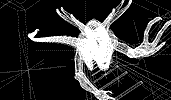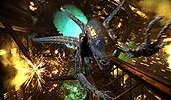
How

How
While the miniature and compositing crews were busy creating the fantastic world in and around the Auriga, another group was trying to realistically portray the title creatures of the ALIEN series. ALIEN RESURRECTION would mark the first time in the series where an alien would be presented from head to toe as computer generated animation.
Blue Sky provided 17 final shots of full motion aliens to ALIEN RESURRECTION--shots that wouldn't be possible to execute with Amalgamated Dynamics' live-action creatures. Mitch Kopelman, Blue Sky's digital effects supervisor, talked with me about the look of the 3D aliens, and how important it was to work with ADI: "When it came to the look of the aliens, the ADI work was not only influencial, but it was the benchmark. We needed to match what they did on set exactly because the director wanted the luxury of intercutting between ADI and Blue Sky's work."
ADI provided Blue Sky with full scale sculptures of body parts of the alien, which were cyberscanned and used as reference. In Alias, the modelers painstakingly duplicated the 3D geometry completely in NURB geometry. Kopelman said, "This was by far the most detailed and complex creature that Blue Sky has ever built." Amazon and Photoshop were used to create the textures of the complicated CG model. "There were many layers of highly complex color and bump maps," Kopelman said, "that gave the alien its gruesome feel and organic quality. A full body shot of the alien has about 250-300MB of texture maps applied."
A big chunk of their work is featured in the underwater sequence, where the heroes swim from one point in the Auriga to another, chased by two aliens. The idea of creating underwater CG elements was exciting to Blue Sky; "We had an opportunity to pull off some effects that have never really been done before," Kopelman remarked. "I can't remember seeing any other underwater CG creatures in a film before."
When creating 3D computer generated imagery to be composited into real world photography, the real world geometry must be created in the computer--a 'stage' for the CG creature to perform within. Kopelman describes the process: "Before the pool was filled with water, we went down with a survey team and surveyed the set for three days, and came up with a data set of around 1000 points. When these 3D locations are brought into Softimage, they create a virtual representation of the set." Using Softimage and Hammerhead tracking software, in addition to detailed reports from the set (including camera reports, distance to subject, etc.), matchmove artists animated the 3D camera, "We had an opportunity to pull off some effects that have never really been done before." Mitch Kopelman
Shooting the underwater background plates was a difficult exercise, in that actors and the first unit camera had to choreograph their actions around an as-of-yet nonexistent alien predator. During rehearsals, divers would play the part of the alien. After some experimentation and discussion, the alien's movement would be determined, and the cameras would roll with the actor being chased by nothing, mimicking his or her movments from before.
"Then," Kopelman said, "for lighting reference we would shoot a diver swimming the path that the alien would be swimming with a white sphere in his hands." Another pass would be photographed with a chrome sphere, and, if time permitted, an ADI alien suit would be dragged through the water. "The white sphere would give us information about the cloudiness of the water and where the lighting was coming from, while the chrome sphere would give us information about what the environment looked like to the alien."
Kerry Shea explained how Blue Sky Studios, the New York-based animation house, became involved in the project: "We gave several different vendors our bible, our big book of storyboards that describes each visual effects shot that we were looking for. What impressed us about Blue Sky was their work on JOE'S APARTMENT. We were looking for alien effects that were sort of insect-like, and they had done such a terrific job on the cockroaches in that film."


A wireframe version of one of the ladder shots, along with its final composite. CG animation by Blue Sky Studios.
so that its movement and position would precisely match the real life camera movement and position.
Blue Sky Studios


. . VFX HQ Produced by Todd Vaziri . . http://www.vfxhq.com . . e-mail: tvaziri@gmail.com . .
All text Copyright © 1998 Todd Vaziri, unless otherwise noted